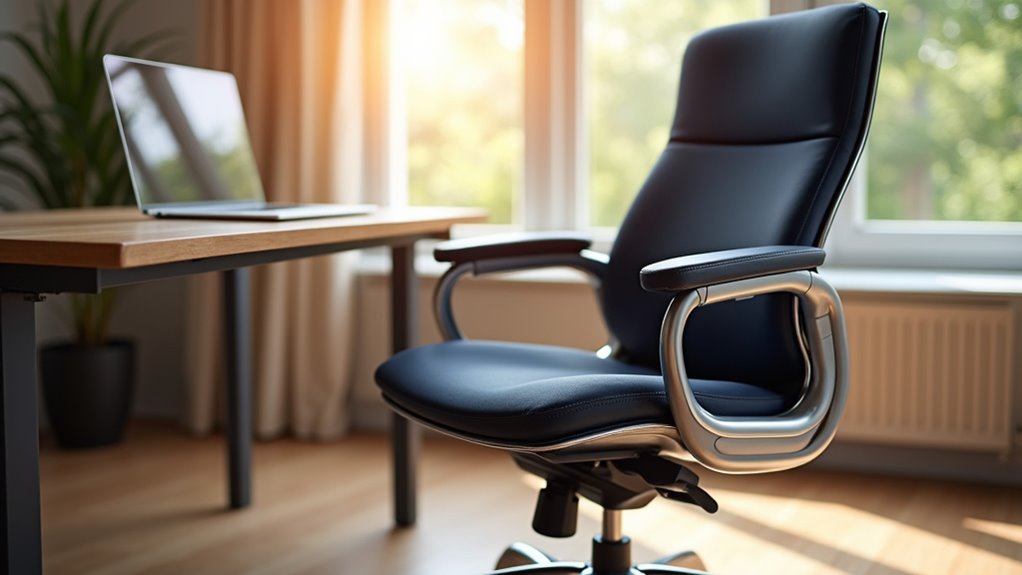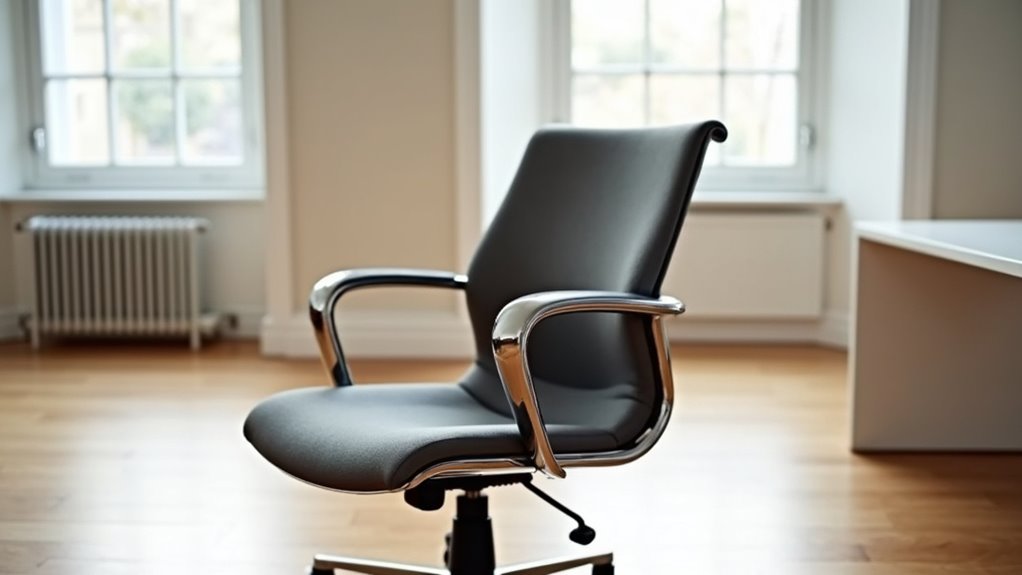How to Choose an Ergonomic Chair
This post contains affiliate links. As an Amazon Associate, we earn from qualifying purchases.
When selecting an ergonomic chair, prioritize the seat height to ensure your feet are flat on the floor and your knees form a 90-degree angle. Additionally, look for adequate lumbar support for proper back alignment and comfort, with a seat depth of 15 to 18 inches. Adjustable armrests are also essential for relieving shoulder tension. For those interested in further details and tips, stay tuned for more insights in the article!
Essential Facts in 30 Seconds
- Ensure seat height is adjustable (16 to 21 inches) for proper foot placement.
- Look for chairs with good lumbar support to maintain spinal alignment.
- Choose a seat depth of 15 to 18 inches, allowing for 2 to 4 inches of knee space.
- Select adjustable armrests to keep elbows at a 90-degree angle.
- Assess build quality; durable materials like metal or strong composites increase longevity.
Understanding Ideal Seat Height and Adjustment Range
Finding the right seat height for your ergonomic chair is essential. Adjustable chairs usually have a height range from 16 to 21 inches. For those who are 5’7″ to 5’10”, aim for a seat height between 17 and 19 inches. Taller people, especially those over 6’7″, may need a seat height of 20 to 22 inches. Shorter users, between 4’11” and 5’2″, should look for a height of 14 to 16 inches.
To discover your ideal height, measure from the floor to the bottom of your kneecap while seated. Make sure your feet are flat on the floor and your knees are at a 90-degree angle. Additionally, achieving the right chair height ensures that both feet are firmly touching the ground, promoting optimal posture and comfort. A proper height also facilitates chair height adjustment, making it easier to find a comfortable position. Furthermore, a well-adjusted chair height can help prevent pressure on thighs and enhance circulation. Also, ensure your chair fits comfortably under your desk. The adjustment mechanism should allow for smooth height changes. This way, everyone can find their perfect seating position! Proper height enhances posture and comfort, making it crucial for overall well-being.
Importance of Lumbar and Back Support Features

Sitting for hours in a chair can be tough on your back. Lumbar support is key for comfort and health. It keeps your spine aligned and reduces strain. This helps lower your chances of back pain. Good lumbar support helps you sit straight and prevents slouching, which can hurt. Additionally, effective lumbar support promotes healthier posture during prolonged sitting. Proper lumbar support reduces tension and helps maintain a natural spine curve, which is essential for overall comfort. Incorporating proper ergonomics while sitting can enhance your overall experience and productivity. Furthermore, ensuring that your chair height is adjustable can greatly impact optimal comfort throughout your workday.
Here are some benefits of lumbar support:
| Benefit | Impact on Health | Result |
|---|---|---|
| Maintains spinal alignment | Reduces strain on lower back | Less chance of chronic pain |
| Distributes pressure evenly | Eases muscle fatigue | Better comfort during long hours |
| Encourages good posture | Minimizes strain on muscles | Supports long-term health |
| Increases blood circulation | Reduces muscle tension | More energy for daily tasks |
Choosing the right chair is important. A good ergonomic chair supports your health. Your back will feel the difference!
Evaluating Seat Depth, Width, and Cushioning
Finding the right seat depth, width, and cushioning is key to comfort. Think of it like choosing the ideal shoes. A good fit helps you feel ready for the day!
For seat depth, aim for 15 to 18 inches. Leave 2 to 4 inches between the edge and your knees. Taller people often need deeper seats, around 17 to 20 inches. Big and tall chairs usually fit them best. Proper chair height adjustment can significantly improve your overall comfort during long hours of sitting, as it ensures that your knees are at a comfortable angle. Adjusting the chair height can also help reduce strain on your lower back.
Next, consider seat width. A width of 17 to 20 inches keeps you comfy without feeling cramped. Wider individuals should look for chairs over 20 inches.
Cushioning is important too! Aim for a thickness of 2 to 4 inches. This will give you a nice balance of softness and support. Proper chair size can prevent back pain and improve posture, enhancing your overall comfort throughout the day. Additionally, using lumbar support cushions can help maintain good posture and reduce strain on your back.
Check for adjustable features. They let you customize your chair for the best fit. Good cushioning keeps you from sinking too deep. No one wants to feel like a chair potato!
The Role of Armrests and Adjustability

Armrests are key to making your ergonomic chair feel great. They offer many benefits that help reduce muscle strain while you work. Adjustable armrests are especially important for comfort and support.
Here are some vital points to consider:
- Reduce shoulder tension: Good support keeps shoulders relaxed, helping to decrease fatigue.
- Promote good posture: Adjustable armrests help you sit naturally, which prevents strain.
- Prevent injuries: They can help avoid problems like carpal tunnel syndrome.
Choose an ergonomic chair with adjustable armrests. This lets you change the height, width, and angle to fit your body. Additionally, ensure that the armrests allow your elbows to rest at a 90-degree angle, which is crucial for optimal arm positioning.
Say goodbye to shoulder shrugging and hello to comfort! Happy arms lead to a happy you. Keep your work hours productive and pain-free!
Assessing Build Quality and Investment Value
Finding the right ergonomic chair matters for your comfort and health.
Build quality is key. A stable base made from metal or strong composites ensures durability. High-quality materials like aluminum or steel make a chair last longer. Replacing the gas cylinder can also enhance the longevity of your chair. Regular maintenance, including inspecting the chair, helps avoid premature wear.
Check the cushion too. Dense foam maintains its shape. Breathable mesh keeps you cool during long hours.
Pay attention to welds and fasteners. Good manufacturing shows in these details. Chairs that meet BIFMA X5.1 standards are often more reliable.
Many think cheaper options save money. But investing in ergonomic features pays off. Better comfort means fewer health issues, and a chair that doesn’t sink can significantly improve your productivity.
A well-built chair supports you like a good friend. Fixing the hydraulics ensures that your chair remains functional and comfortable for long hours of sitting. Choose wisely for your long hours of sitting!
Frequently Asked Questions
How Do I Maintain My Ergonomic Chair for Longevity?
Maintain your ergonomic chair to keep it lasting longer. Clean it every three months. Use a soft cloth and mild soap. Check for loose screws and bolts. Tighten them if needed. Lubricate moving parts to keep them working smoothly. Adjust the chair height and backrest for comfort. Follow these steps to enjoy your chair for years. A little care goes a long way.
Can I Use an Ergonomic Chair Without a Desk?
Using an ergonomic chair without a desk is perfectly fine. These chairs help you sit correctly. They make you comfortable while reading, gaming, or relaxing. An ergonomic chair reduces strain on your body. It supports your back and encourages good posture. You can enjoy many benefits even without a desk. Comfort matters, and an ergonomic chair provides that. Enjoy your time, whether you’re working or just chilling.
What’S the Average Lifespan of an Ergonomic Chair?
An ergonomic chair can last between 7 to 15 years. This lifespan depends on how often you use it and the quality of the chair. Signs of wear include squeaks, tears, or flat padding. These signs mean it may be time for a replacement. A good ergonomic chair supports your body and helps prevent pain. Investing in a quality chair pays off in comfort and health. Choose wisely for the best experience.
Are There Specific Ergonomic Chairs for Taller Individuals?
Ergonomic chairs exist for taller people. These chairs have special features. They often come with higher backrests. A deeper seat pan is also common. Adjustable height is important too. Lumbar support helps maintain good posture. Comfort is key for long hours of sitting. Investing in the right chair can make a big difference. Choose one that fits your height and needs. This way, you can work or relax without discomfort.
How Do I Choose a Chair for Gaming Versus Office Use?
Choosing a chair for gaming or office use matters. Gaming chairs often have bright colors and unique designs. They look fun and exciting. Office chairs focus on comfort and support. They help you stay productive for long hours.
Think about how you will use the chair. Gamers need chairs that offer good back support. They also need chairs that can move easily. Office workers need chairs that help them sit straight. Comfort is key for both types.
Look for chairs with adjustable features. This includes height, armrests, and lumbar support. Good chairs help prevent pain and discomfort.
Pick a style that makes you happy. A chair should match your space and personality. Balance style with comfort for the best choice.
Conclusion
Picking the right ergonomic chair is important. Check the seat height first. It should allow your feet to rest flat on the floor. Good back support is a must. A chair that fits your back helps prevent pain.
A comfy chair can increase your productivity by 20%. That means more time for your favorite activities! Take your time to find a chair that feels good. A good chair makes long study sessions easier. Enjoy the search, and keep your back happy and healthy!
